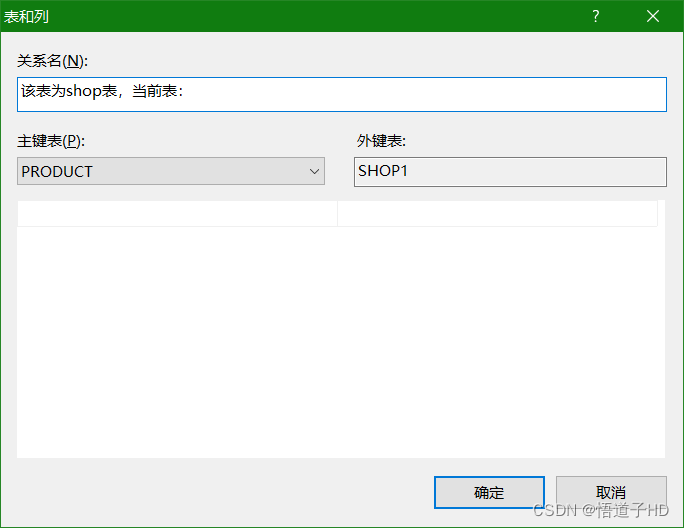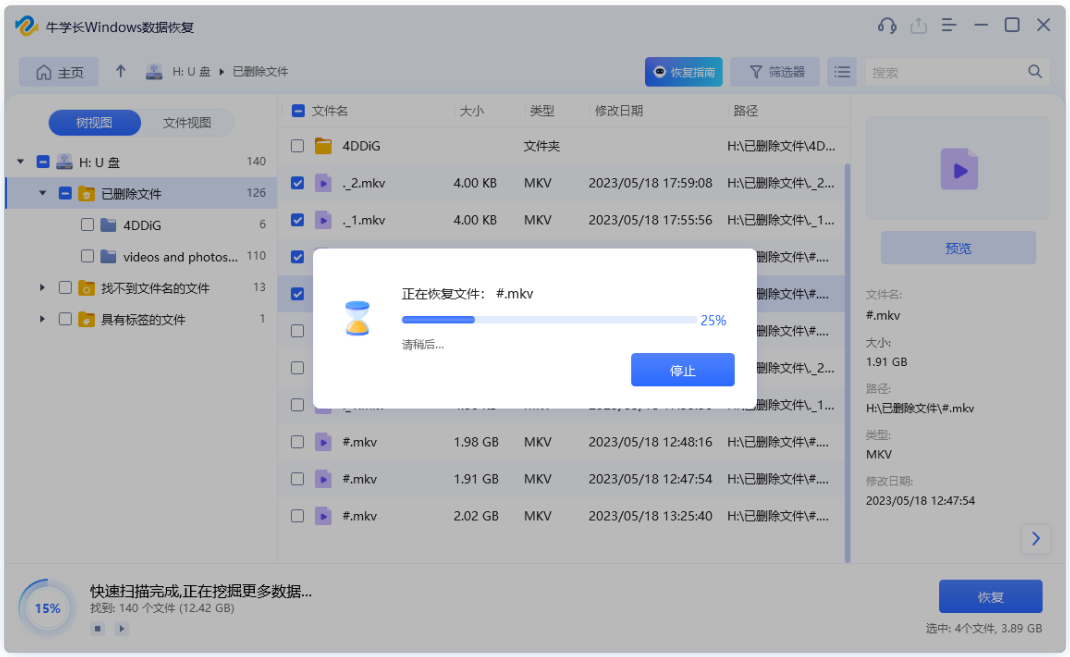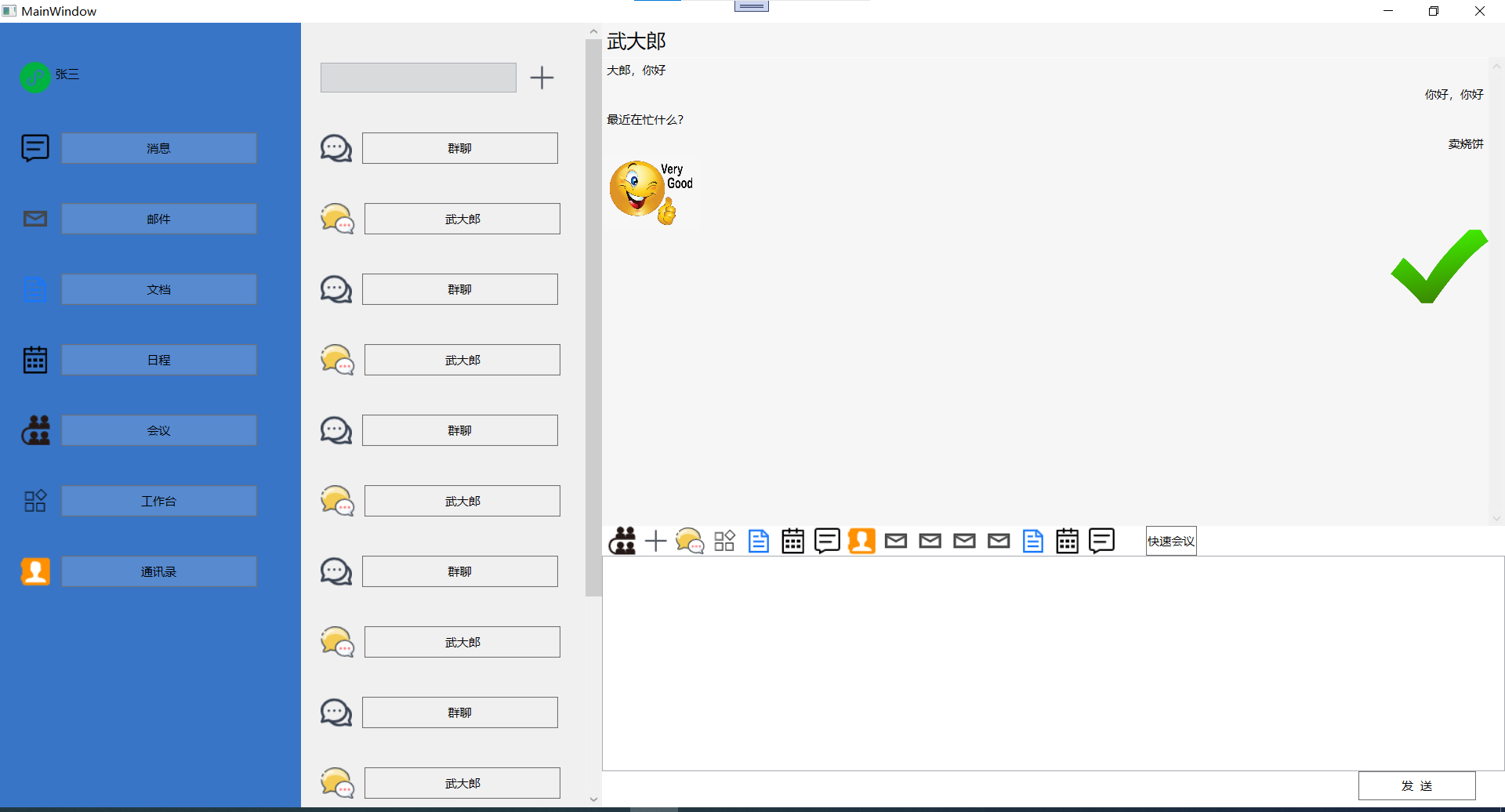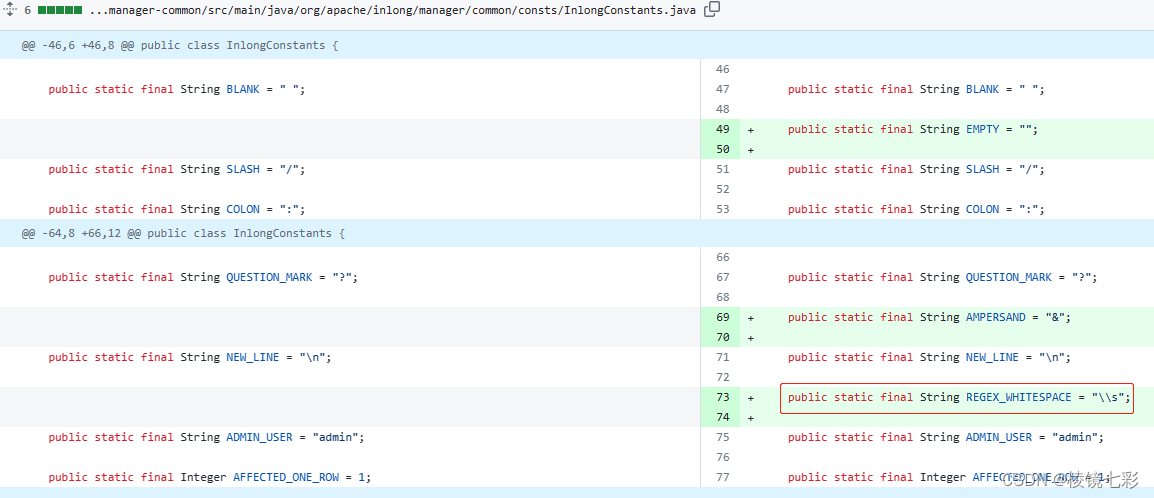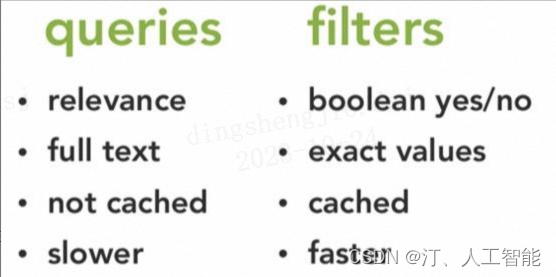说明
一切节点的跟是 machine-root,同一个资源在不同链路会创建多个DefaultNode,但是在全局只会创建一个 ClusterNode
machine-root/\/ \EntranceNode1 EntranceNode2/ \/ \DefaultNode(nodeA) DefaultNode(nodeA)| |- - - - - - + - - - - - - - - - +- - - - - - -> ClusterNode(nodeA);如我们所见,在两个上下文中为“nodeA”创建了两个 DefaultNode,但只创建了一个 ClusterNode
一切的开始
DispatcherServlet是Spring MVC框架中的核心组件,它作为前置控制器,它拦截匹配的请求,并根据相应的规则分发到目标Controller来处理。当请求进入后,首先会执行DispatcherServlet 的 doDispatch 方法
public class DispatcherServlet extends FrameworkServlet {protected void doDispatch(HttpServletRequest request, HttpServletResponse response) throws Exception {···try {try {···// 执行preHandle方法 // 会进入AbstractSentinelInterceptor 的 preHandle// 会为当前访问的controller接口创建资源if (!mappedHandler.applyPreHandle(processedRequest, response)) {return;}// Actually invoke the handler.// 最终会执行SentinelResourceAspect#invokeResourceWithSentinel(pjp);// 为所有添加注解的方法创建资源mv = ha.handle(processedRequest, response, mappedHandler.getHandler());if (asyncManager.isConcurrentHandlingStarted()) {return;}···}catch (Exception ex) {···}}catch (Exception ex) {···}}
}因此,从这里就可以知道,簇点链路中,默认使用 controller 创建的资源一定在使用注解创建的资源之前创建,也就是说,使用注解创建的资源只能作为使用 controller 创建的资源的子节点。
链路创建过程分析
创建 EntranceNode
上面说到,执行会进入AbstractSentinelInterceptor 的 preHandle,进行资源创建
public abstract class AbstractSentinelInterceptor implements HandlerInterceptor {public static final String SENTINEL_SPRING_WEB_CONTEXT_NAME = "sentinel_spring_web_context";@Overridepublic boolean preHandle(HttpServletRequest request, HttpServletResponse response, Object handler) throws Exception {try {// 获取资源名,也就是 /order/{orderId}String resourceName = getResourceName(request);if (StringUtil.isEmpty(resourceName)) {return true;}if (increaseReferece(request, this.baseWebMvcConfig.getRequestRefName(), 1) != 1) {return true;}// Parse the request origin using registered origin parser.String origin = parseOrigin(request);// contextName默认是sentinel_spring_web_context,// 如果不想使用这个,而是使用Controller接口路径作为contextName,则需要在application.yml文件中关闭context整合// spring.cloud.sentinel.web-context-unify=falseString contextName = getContextName(request);// 创建context// Context初始化的过程中,会创建EntranceNode,contextName就是EntranceNode的名称ContextUtil.enter(contextName, origin);// 创建资源,簇点链路的形成就在里面Entry entry = SphU.entry(resourceName, ResourceTypeConstants.COMMON_WEB, EntryType.IN);request.setAttribute(baseWebMvcConfig.getRequestAttributeName(), entry);return true;} catch (BlockException e) {···}}
}
在获取 contextName 时,会先判断有没有关闭 context 整合,然后选择返回默认的sentinel_spring_web_contex还是从接口中获取url
@Override
protected String getContextName(HttpServletRequest request) {if (config.isWebContextUnify()) {return super.getContextName(request);}return getResourceName(request);
}@Override
protected String getResourceName(HttpServletRequest request) {// Resolve the Spring Web URL pattern from the request attribute.Object resourceNameObject = request.getAttribute(HandlerMapping.BEST_MATCHING_PATTERN_ATTRIBUTE);if (resourceNameObject == null || !(resourceNameObject instanceof String)) {return null;}String resourceName = (String) resourceNameObject;UrlCleaner urlCleaner = config.getUrlCleaner();if (urlCleaner != null) {resourceName = urlCleaner.clean(resourceName);}// Add method specification if necessaryif (StringUtil.isNotEmpty(resourceName) && config.isHttpMethodSpecify()) {resourceName = request.getMethod().toUpperCase() + ":" + resourceName;}return resourceName;
}然后会进行 context 的创建
protected static Context trueEnter(String name, String origin) {// 第一次肯定为空Context context = contextHolder.get();if (context == null) {// contextNameNodeMap 有1个值(EntranceNode是DefaultNode的子类,是一种特殊的DefaultNode)// 1. sentinel_default_context -> {EntranceNode@10330} Map<String, DefaultNode> localCacheNameMap = contextNameNodeMap;// 根据传入的contextName选择看有没有这个name的EntranceNodeDefaultNode node = localCacheNameMap.get(name);// 如果没有就创建一个if (node == null) {if (localCacheNameMap.size() > Constants.MAX_CONTEXT_NAME_SIZE) {setNullContext();return NULL_CONTEXT;} else {LOCK.lock();try {node = contextNameNodeMap.get(name);if (node == null) {if (contextNameNodeMap.size() > Constants.MAX_CONTEXT_NAME_SIZE) {setNullContext();return NULL_CONTEXT;} else {// 创建一个新的EntranceNodenode = new EntranceNode(new StringResourceWrapper(name, EntryType.IN), null);// Add entrance node.// Constants.ROOT是一个EntranceNode, id是machine-root// 将当前创建的EntranceNode添加为Constants.ROOT的子节点Constants.ROOT.addChild(node);Map<String, DefaultNode> newMap = new HashMap<>(contextNameNodeMap.size() + 1);newMap.putAll(contextNameNodeMap);newMap.put(name, node);contextNameNodeMap = newMap;}}} finally {LOCK.unlock();}}}// 创建一个新的contextcontext = new Context(node, name);context.setOrigin(origin);contextHolder.set(context);}return context;
}创建 DefaultNode
创建资源时,首先会创建一个 slot 执行链,然后依次执行。
第一个节点是 NodeSelectSlot,在里面完成 DefaultNode 的创建。

当第一次访问时,NodeSelectorSlot 中
// volatile保证map多线程的可见性
// 非static变量,每次创建对象时都创建一个新的
private volatile Map<String, DefaultNode> map = new HashMap<String, DefaultNode>(10);@Override
public void entry(Context context, ResourceWrapper resourceWrapper, Object obj, int count, boolean prioritized, Object... args) throws Throwable {// 第一次一定是空,同一个链路中的资源之后的请求不为空// 不同链路中的资源,后续的请求中,第一次访问还是空DefaultNode node = map.get(context.getName());if (node == null) {synchronized (this) {node = map.get(context.getName());if (node == null) {// 创建一个DefaultNode,将他放入到map中node = new DefaultNode(resourceWrapper, null);HashMap<String, DefaultNode> cacheMap = new HashMap<String, DefaultNode>(map.size());cacheMap.putAll(map);cacheMap.put(context.getName(), node);// 更新mapmap = cacheMap;// Build invocation tree// 将刚创建的node设置为当前node的子节点((DefaultNode) context.getLastNode()).addChild(node);}}}// 设置当前节点为刚创建的节点context.setCurNode(node);fireEntry(context, resourceWrapper, node, count, prioritized, args);
}下面的图是访问/order/query/{name}接口创建的资源

下面的图是访问/order/query/{name}接口创建的资源,不过在这个 Controller 接口里面又调用了 service 中添加了@SentinelResource注解的方法。根据上面的分析,基于注解的资源后创建,因此它作为基于 Controller 创建的资源的子节点
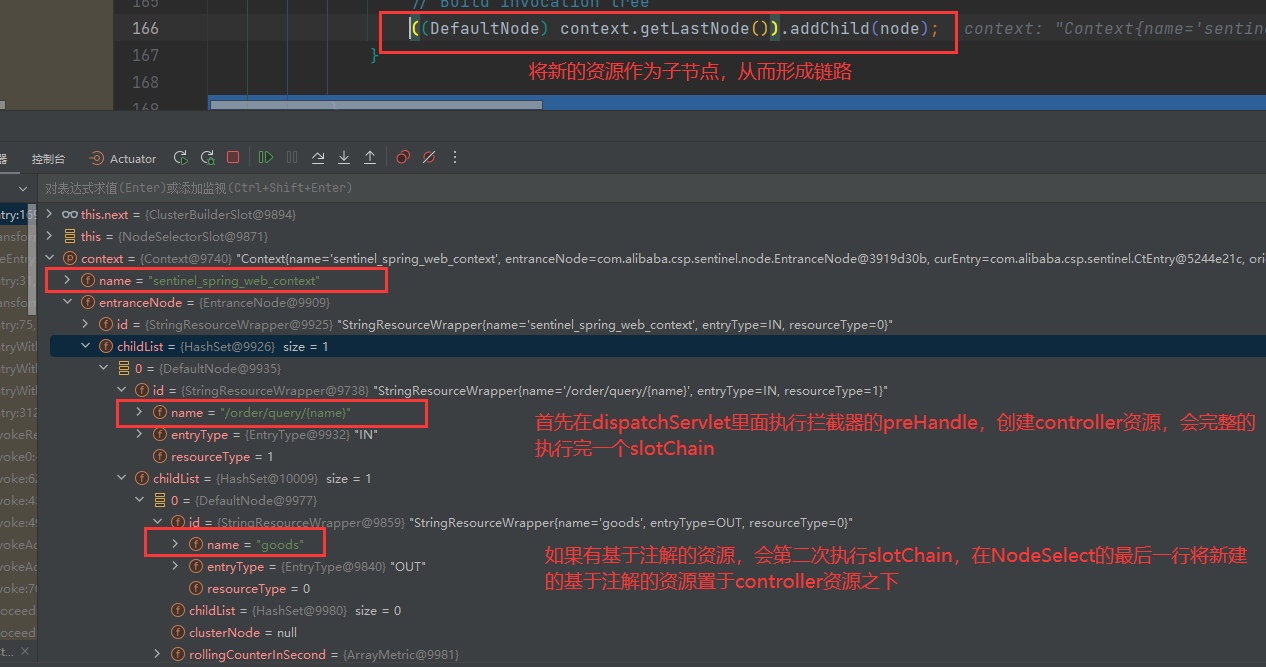
第二次访问/order/query/{name}接口,在NodeSelectorSlot中,node 会获取到,因此直接执行后边的操作

如果 controller 接口上加了@SentinelResource,还是先创建 controller 资源,然后创建 controller 基于注解的资源,然后是 service 的资源。下面的图中,在/order/query/{name}Controller 接口上添加了@SentinelResource注解。
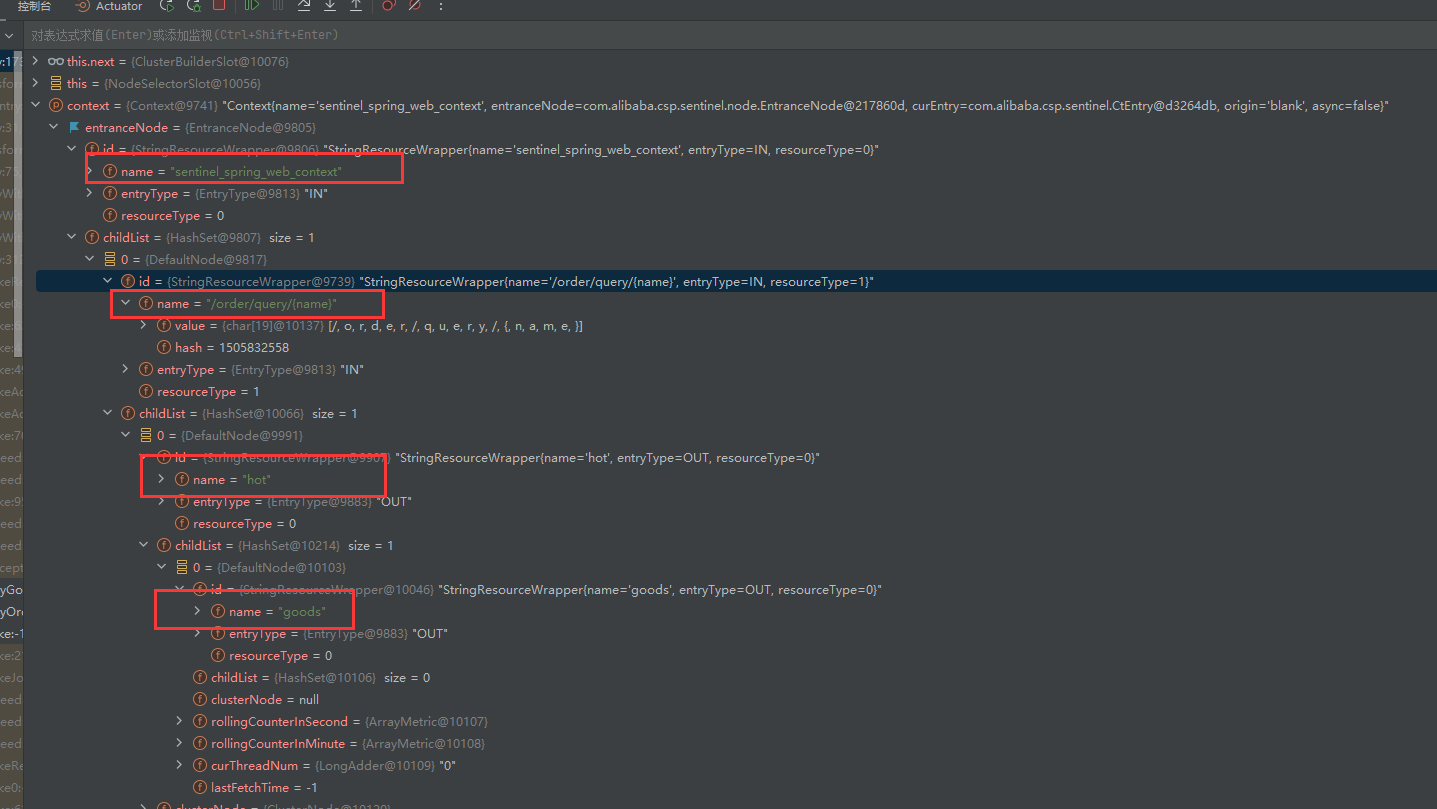

feign 对 Sentinel 支持
开启 feign 对 Sentinel 的支持后,Sentinel 会将 feign 的请求添加到簇点链路中
feign.sentinel.enabled=true在 Sentinel 的 jar 中,使用 spi 机制加载了一个类com.alibaba.cloud.sentinel.feign.SentinelFeignAutoConfiguration
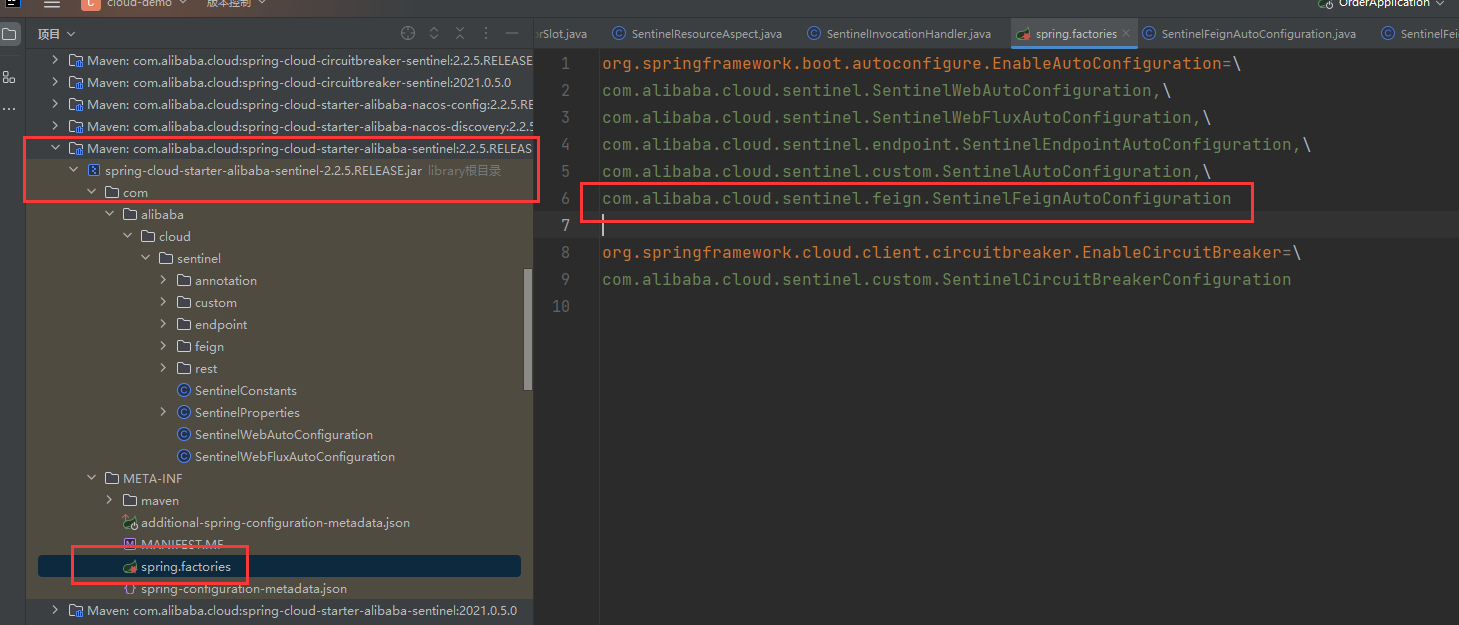
SentinelFeignAutoConfiguration 配置类里定义了Feign.Builder 的实现类 SentinelFeign.builder()
@Configuration(proxyBeanMethods = false)
@ConditionalOnClass({ SphU.class, Feign.class })
public class SentinelFeignAutoConfiguration {@Bean@Scope("prototype")@ConditionalOnMissingBean@ConditionalOnProperty(name = "feign.sentinel.enabled") // 配置项为true时该bean生效public Feign.Builder feignSentinelBuilder() {return SentinelFeign.builder();}}SentinelFeign.builder( ) 的 build( ) 方法
主要作用是: 创建 invocationHandlerFactory,重写create( ) 方法;invocationHandlerFactory 用于创建 SentinelInvocationHandler ,代替前面的 FeignCircuitBreakerInvocationHandler。
public Feign build() {super.invocationHandlerFactory(new InvocationHandlerFactory() {public InvocationHandler create(Target target, Map<Method, MethodHandler> dispatch) {GenericApplicationContext gctx = (GenericApplicationContext)Builder.this.applicationContext;BeanDefinition def = gctx.getBeanDefinition(target.type().getName());FeignClientFactoryBean feignClientFactoryBean = (FeignClientFactoryBean)def.getAttribute("feignClientsRegistrarFactoryBean");// 从BeanDefinition 里获取到 fallback、fallbackFactory Class fallback = feignClientFactoryBean.getFallback();Class fallbackFactory = feignClientFactoryBean.getFallbackFactory();String beanName = feignClientFactoryBean.getContextId();if (!StringUtils.hasText(beanName)) {beanName = feignClientFactoryBean.getName();}if (Void.TYPE != fallback) {// 创建 fallback 实例Object fallbackInstance = this.getFromContext(beanName, "fallback", fallback, target.type());// 创建 SentinelInvocationHandlerreturn new SentinelInvocationHandler(target, dispatch, new org.springframework.cloud.openfeign.FallbackFactory.Default(fallbackInstance));} else if (Void.TYPE != fallbackFactory) {FallbackFactory fallbackFactoryInstance = (FallbackFactory)this.getFromContext(beanName, "fallbackFactory", fallbackFactory, FallbackFactory.class);return new SentinelInvocationHandler(target, dispatch, fallbackFactoryInstance);} else {return new SentinelInvocationHandler(target, dispatch);}}private Object getFromContext(String name, String type, Class fallbackType, Class targetType) {Object fallbackInstance = Builder.this.feignContext.getInstance(name, fallbackType);if (fallbackInstance == null) {throw new IllegalStateException(String.format("No %s instance of type %s found for feign client %s", type, fallbackType, name));} else if (!targetType.isAssignableFrom(fallbackType)) {throw new IllegalStateException(String.format("Incompatible %s instance. Fallback/fallbackFactory of type %s is not assignable to %s for feign client %s", type, fallbackType, targetType, name));} else {return fallbackInstance;}}});super.contract(new SentinelContractHolder(this.contract));return super.build();
}在 invoke 方法里面为feign请求创建资源创建资源
@Override
public Object invoke(final Object proxy, final Method method, final Object[] args) throws Throwable {if ("equals".equals(method.getName())) {try {Object otherHandler = args.length > 0 && args[0] != null? Proxy.getInvocationHandler(args[0]): null;return equals(otherHandler);}catch (IllegalArgumentException e) {return false;}}else if ("hashCode".equals(method.getName())) {return hashCode();}else if ("toString".equals(method.getName())) {return toString();}Object result;MethodHandler methodHandler = this.dispatch.get(method);// only handle by HardCodedTargetif (target instanceof Target.HardCodedTarget) {Target.HardCodedTarget hardCodedTarget = (Target.HardCodedTarget) target;MethodMetadata methodMetadata = SentinelContractHolder.METADATA_MAP.get(hardCodedTarget.type().getName()+ Feign.configKey(hardCodedTarget.type(), method));// resource default is HttpMethod:protocol://urlif (methodMetadata == null) {result = methodHandler.invoke(args);}else {String resourceName = methodMetadata.template().method().toUpperCase()+ ":" + hardCodedTarget.url() + methodMetadata.template().path();Entry entry = null;try {ContextUtil.enter(resourceName);// 为feign请求创建资源entry = SphU.entry(resourceName, EntryType.OUT, 1, args);// 调用服务端接口result = methodHandler.invoke(args);}catch (Throwable ex) {// fallback handleif (!BlockException.isBlockException(ex)) {Tracer.trace(ex);}if (fallbackFactory != null) {try {//异常时 调用熔断逻辑Object fallbackResult = fallbackMethodMap.get(method).invoke(fallbackFactory.create(ex), args);return fallbackResult;}catch (IllegalAccessException e) {····}}else {···}}finally {···}}}else {result = methodHandler.invoke(args);}return result;
}如果 service 中使用 feign,则 feign 的调用 也会现实在链路中,他和使用注解创建的service 资源是同级的,但是先创建 feign,后创建 service 注解资源


使用注解和 feign 创建的资源,EntryType 都是 OUT,只有 controller 资源的EntryType 是 IN。
EntryType:枚举标记资源调用方向。
创建ClusterNode
在创建 ClusterNode 时,使用 static 变量存储。将创建的 ClusterNode 与当前 node 进行关联。
/*** 请记住,相同的资源(ResourceWrapper.equals(Object))将在全局范围内共享相同的ProcessorSlotChain,而与上下文无关。* 因此,如果代码进入entry(Context,ResourceWrapper,DefaultNode,int,boolean,Object...),* 则资源名称必须相同,但上下文名称可能不同。要获得不同上下文中相同资源的总统计数据,* 相同的资源在全局范围内共享相同的ClusterNode。此映射在应用运行时间越长,就会变得越稳定。* 因此,我们不使用并发映射,而是使用锁。因为此锁仅在开始时发生,而并发映射将始终保持锁定状态。*/
private static volatile Map<ResourceWrapper, ClusterNode> clusterNodeMap = new HashMap<>();@Override
public void entry(Context context, ResourceWrapper resourceWrapper, DefaultNode node, int count,boolean prioritized, Object... args) throws Throwable {// 如果不是第一次访问这个资源,则clusterNode是一定有的// 所以直接将DefaultNode和ClusterNode进行关联// 因为保存ClusterNode的map是static 的,因此全局共享,且创建后内容一直存在// 因此一个资源只会创建一次ClusterNodeif (clusterNode == null) {synchronized (lock) {if (clusterNode == null) {// Create the cluster node.clusterNode = new ClusterNode(resourceWrapper.getName(), resourceWrapper.getResourceType());HashMap<ResourceWrapper, ClusterNode> newMap = new HashMap<>(Math.max(clusterNodeMap.size(), 16));newMap.putAll(clusterNodeMap);newMap.put(node.getId(), clusterNode);clusterNodeMap = newMap;}}}node.setClusterNode(clusterNode);/** if context origin is set, we should get or create a new {@link Node} of* the specific origin.*/if (!"".equals(context.getOrigin())) {Node originNode = node.getClusterNode().getOrCreateOriginNode(context.getOrigin());context.getCurEntry().setOriginNode(originNode);}fireEntry(context, resourceWrapper, node, count, prioritized, args);
}说明
如果一个请求中要经过多个资源保护的方法(controller 资源*1,注解资源*n),则上面的流程会进行多次,分别根据资源创建类型执行对应的方法,从而将每次的资源添加到前面资源的字节的中,形成于给完整的簇点链路
后面就是限流的一些 slot




